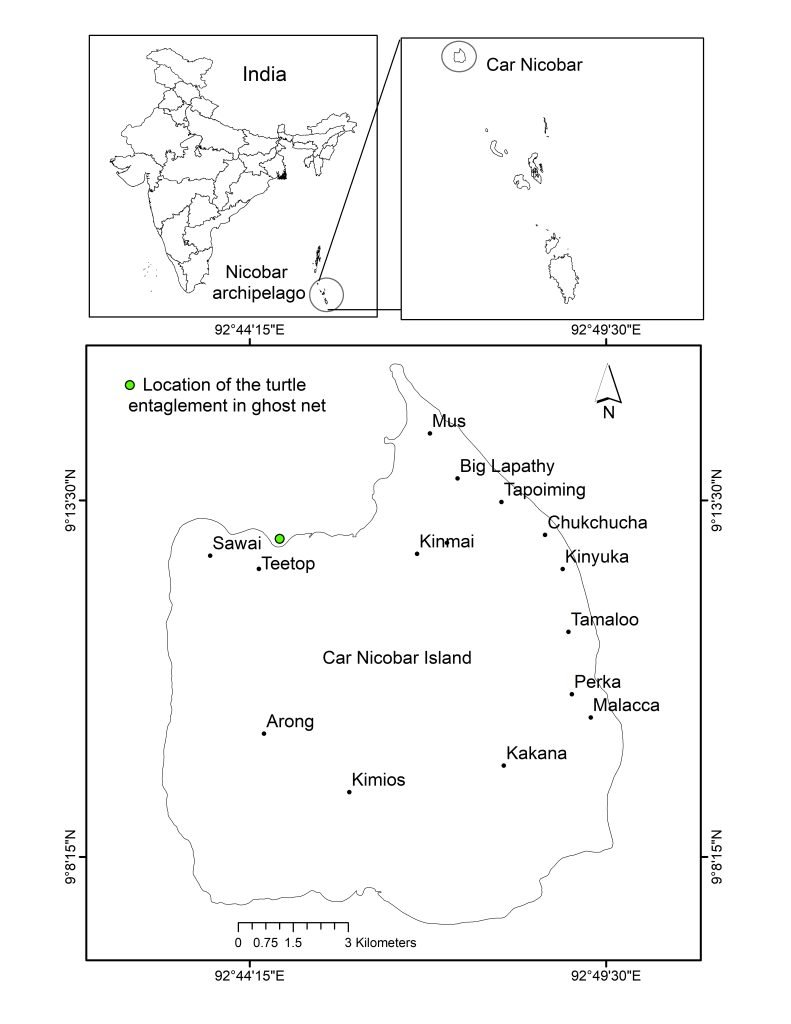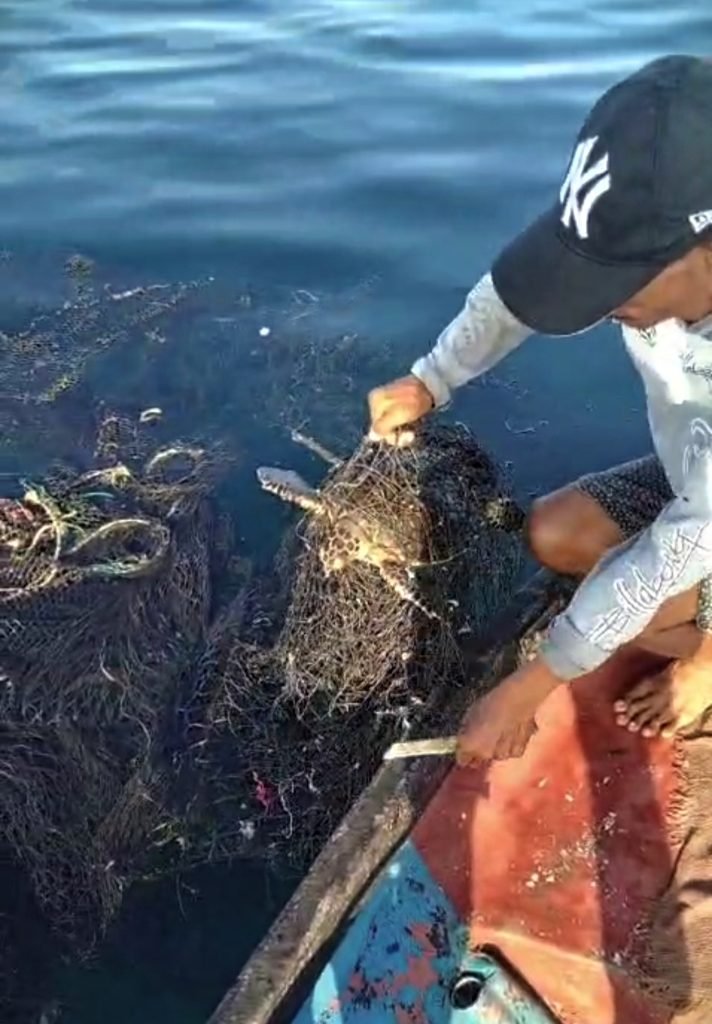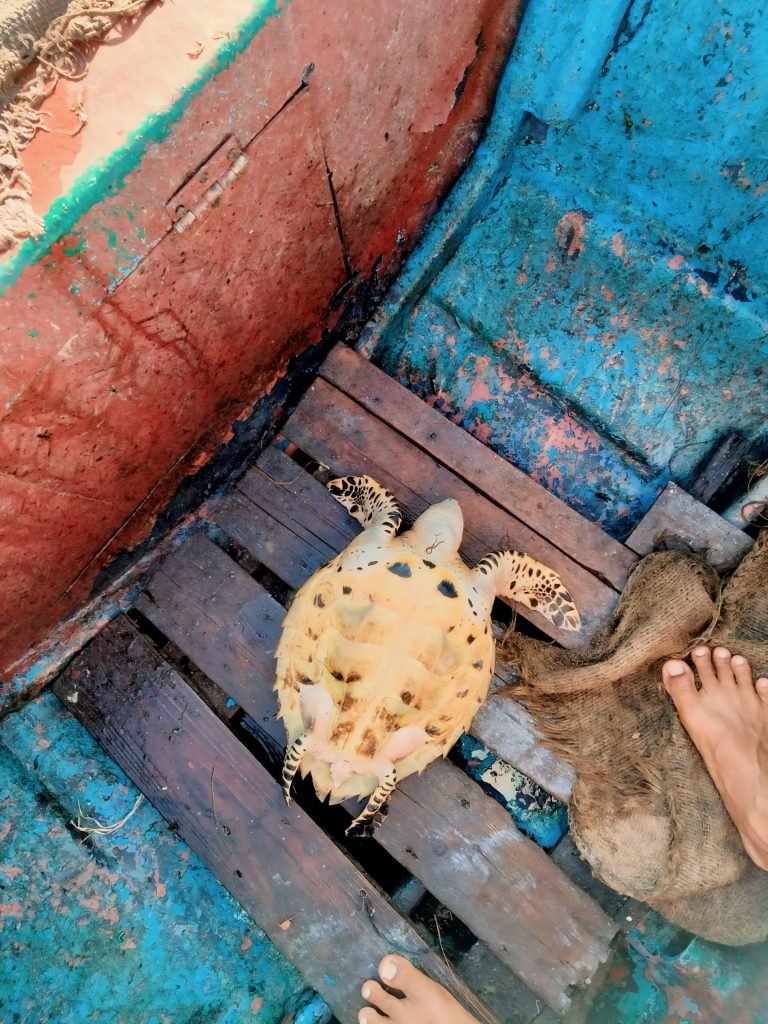RELEASE OF A HAWKSBILL TURTLE CAUGHT LIVE IN A GHOST NET- AN OUTCOME OF CITIZEN SCIENCE INITIATIVES AT CAR NICOBAR, ANDAMAN AND NICOBAR ARCHIPELAGO
RAJENDRAN KIRUBA SANKAR1#, KANDASAMY SARAVANAN1, JAYASIMHAN PRAVEENRAJ1, YUVRAJ ESWARAN2 & AKSHATHA SORATUR3
1ICAR- Central Island Agricultural Research Institute, Port Blair, Andaman and Nicobar Islands
2Department of Coastal Disaster Management, Pondicherry University, Port Blair, Andaman and Nicobar Islands
3Department of Marine Biology, Pondicherry University, Port Blair, Andaman and Nicobar Islands
#rkirubasankar@gmail.com
Download article as PDF
The issue of sea turtles becoming entangled in abandoned ghost nets has been reported across the world and is now a threat to sea turtles in some regions, including the Indian Ocean (Wilcox et al., 2013; Stelfox & Hudgins, 2015; Tyabji & Patankar, 2017; Stelfox et al., 2020). The issue of ghost nets and their potential impact on sea turtles has previously been reported in the Andaman Islands but not elsewhere in the Andaman and Nicobar archipelago (Tyabji & Patankar, 2017).
In the Nicobar Islands, Car Nicobar is a small island inhabited by tribal groups who depend on marine fishing activities for their livelihood and subsistence needs (Kiruba-Sankar et al., 2020, 2023a). During fishing operations on the forenoon of 1st April 2024, in the coastal waters off Teetop village of Car Nicobar, some tribal Nicobarese fishers spotted a live sea turtle trapped in a floating ghost net (Figures 1 and 2). As part of the citizen science initiatives implemented in Car Nicobar, the tribal fishers were aware of the ecological significance of sea turtles and the need for their conservation (Nicobar Times, 2023, 2024). They approached the ghost net and removed the entangled turtle by cutting the net, then released the sea turtle after it was freed. Examination of videos and photos identified the turtle as a juvenile hawksbill turtle (Eretmochelys imbricata) (Figure 3). In a video shared by the fishers, the authors of this observation could see a decomposing dead turtle also entangled in the net, however, we could not identify the species.
 Figure 1. Location of ghost gear at Car Nicobar.
Figure 1. Location of ghost gear at Car Nicobar. Figure 2. Juvenile hawksbill turtle entangled in ghost gear at Car Nicobar. (Photo credit: Junaid Khan)
Figure 2. Juvenile hawksbill turtle entangled in ghost gear at Car Nicobar. (Photo credit: Junaid Khan) Figure 3. Juvenile hawksbill turtle freed from ghost gear at Car Nicobar. (Photo credit: Junaid Khan)
Figure 3. Juvenile hawksbill turtle freed from ghost gear at Car Nicobar. (Photo credit: Junaid Khan)
Hawksbill turtles are recognized as keystone species in coral reef and seagrass ecosystems (Patel et al., 2022). The Andaman and Nicobar Islands are home to nesting and foraging populations of hawksbill turtles (Bhaskar, 1979, Swaminathan et al., 2017). Sea turtles in the area may be legally caught for local consumption by tribal communities (Kiruba-Sankar et al., 2023b).
Understanding the dynamics of sea turtle abundance in the Car Nicobar coastal waters has been the primary focus of the collaborative program launched by ICAR- Central Island Agricultural Research Institute, Port Blair, and the Department of Science and Technology, New Delhi. A series of awareness programs supported the citizen science initiatives on sea turtle monitoring (Nicobar Times, 2023, 2024) which led to the report of this turtle entangled in a ghost net.
Abandoned fishing gear remains a hazard to marine wildlife in the coastal waters of Car Nicobar Island (Kiruba-Sankar et al., 2023c). In the future, more knowledge about the detrimental impacts of abandoned fishing gear on vulnerable marine animals, like sea turtles, should be facilitated through interactions with the local communities. To stop future occurrences of entanglement, the local tribes could also be involved in recovering abandoned fishing gear from Car Nicobar’s waters.
ACKNOWLEDGMENTS
The work was conducted under the DST-funded project Augmenting Livelihood, Resilience, and Knowledge Generation through the coastal fisheries information hub for the Nicobar tribes of Car Nicobar Island. The local tribal fisherman provided the authors with timely information on the ghost net entanglement, which is acknowledged. The authors also acknowledge the continuous assistance and motivation from Dr. Eaknath B. Chakurkar, Director of CIARI, to complete the work at Car Nicobar.
Literature cited:
Bhaskar, S. 1979. Sea turtle survey in the Andaman and Nicobars. Hamadryad 4: 1-26.
Kiruba-Sankar, R., K.L. Kumar, R.J. Angel, S.S. Salim, K. Saravanan, P. Krishnan, T. Ravikumar et al. 2020. Impact evaluation of marine fisheries interventions among tribal fisher commune of Car Nicobar Island, India. Journal of Marine Biological Association of India 62: 84-89.
Kiruba-Sankar, R., H. Haridas, S.K. Pandey, Z. George, K. Saravanan, Y. Gladston, J. Praveenraj et al. 2023a. The Nicobarese tribes and their coastal fishing activities during the COVID-19 pandemic-related restrictions- preliminary findings. Journal of Coastal Conservation 27: 11. DOI: 10.1007/s11852-023-00942-2.
Kiruba-Sankar, R., J. Barman, K. Saravanan, J. Praveenraj, Y. Eswaran, S. Adamala & L. Meshack. 2023b. Record of a hawksbill sea turtle at Car Nicobar, Andaman and Nicobar archipelago. Indian Ocean Turtle Newsletter 38: 17-19.
Kiruba-Sankar, R., K. Saravanan, S. Adamala, K. Selvam, K.L. Kumar & J. Praveenraj. 2023c. First report of marine debris in Car Nicobar, a remote oceanic Island in the Nicobar archipelago, Bay of Bengal. Regional Studies in Marine Science 61: 102845. DOI: 10.1016/j.rsma.2023.102845.
Nicobar Times. 2023. Awareness campaign on sea turtle nesting and habitat conservation concludes at Car Nicobar Island. https://nicobartimes.com/local-news/awareness-campaign-on-sea-turtle-nesting-and-habitat-conservation-concludes-at-car-nicobar-island/. Accessed on April 01, 2024.
Nicobar Times. 2023. Marine turtle monitoring training program held at Car Nicobar Island. https://nicobartimes.com/local-news/marine-turtle-monitoring-training-program-held-at-car-nicobar-island/. Accessed on April 01, 2024.
Patel, E., M. Kotera & A.D. Phillott. 2022. The role of sea turtles in ecosystem process and services. Indian Ocean Turtle Newsletter 36: 23-31.
Stelfox, M.R & J.A. Hudgins. 2015. A two-year summary of turtle entanglements in ghost gear in the Maldives. Indian Ocean Turtle Newsletter 22: 14-20.
Stelfox, M., A. Burian, K. Shanker, A.F. Rees, C. Jean, M.S. Willson, N.A. Manik et al. 2020. Tracing the origin of olive ridley turtles entangled in ghost nets in the Maldives: A phylogeographic assessment of populations at risk. Biological Conservation 245: 108499. DOI: 10.1016/j.biocon.2020.108499.
Swaminathan A., S. Thesorow, S. Watha, M. Manoharakrishnan, N. Namboothri & M. Chandi. 2017. Current status and distribution of threatened leatherback turtles and their nesting beaches in the Nicobar group of Islands. Indian Ocean Turtle Newsletter 25: 12-18.
Tyabji, Z. & V. Patankar. 2017. Entanglement of a juvenile olive ridley turtle in a ghost net in the Andaman Islands. Indian Ocean Turtle Newsletter 26: 5-7.
Wilcox, C., B.D. Hardesty, R. Sharples, D.A. Griffin, T.J. Lawson & R. Gunn. 2013. Ghostnet impacts on globally threatened turtles, a spatial risk analysis for northern Australia. Conservation Letters 6: 247-254.